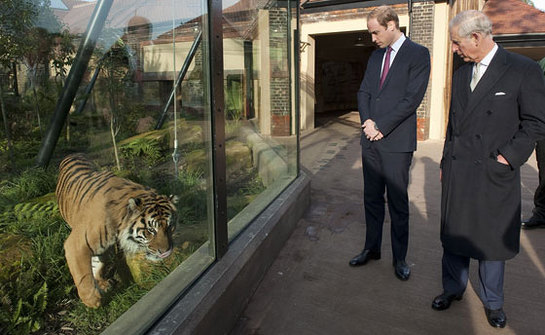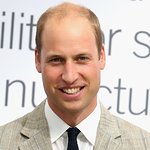The Duke of Cambridge declared his new United for Wildlife project can make a real difference to animal conservation as he marvelled at London Zoo’s star attractions – the tigers.

Credit/Copyright: DukeAndDuchessOfCambridge.org
The Duke was joined by his father, The Prince of Wales, as he convened the first official meeting of the umbrella organisation he has assembled to help tackle the threat to the world’s wildlife.
Before the talks began, the two men – who are both passionate about conservation – toured the tiger enclosure and got close to some of the big cats that face an uncertain future in the wild.
During the tour, The Duke spoke about his plans for United for Wildlife, saying he wanted to get conservation leaders and experts around the table.
He added that he wanted to get “them in one room to focus their energy and their commitment to one cause – particularly obviously this illegal wildlife trade at the moment is such a big issue”.
“The idea was that United for Wildlife can progress and we can really start the ball rolling and the momentum and really try and change and tackle this issue,” he said.
The Duke went on: "Education is the most important thing as we saw with the shark fin soup campaign – the more education, the more obviously we can put out there and show people and educate them on what they’re buying and what they’re seeing and really try and change their attitudes.
“I think we’ve got a real chance of changing the way things are going.”
The Prince said the need to reduce the markets for illegal animal products was a crucial issue.
Speaking during his tour of London Zoo, he said: "One of the most important things is helping the NGOs who struggle away, particularly organisations like Traffic (the wildlife trade monitoring network) and WildAid (anti-illegal wildlife trade body) and the World Wildlife Fund, of which I’m President in the UK.
“They’re doing a fantastic job but they’re up against a huge series of obstacles.”
He added: "The most important thing to remember, I think, is that you have to reduce consumption of illegal wildlife parts, whether it’s ivory, or rhino horn, tiger parts, or whatever from various endangered species.
“So that it’s the consumption in Asia and elsewhere which is one of the key issues and they’ve already shown – organisations like WildAid and Traffic – that you can seriously reduce, for instance, shark fin consumption, which is another huge problem, the cutting the fins off sharks, by this sort of approach.
“So they need as much help and attention paid to them, and raising of the profile – that’s half the battle of this, really.”
The Duke’s Royal Foundation is working with seven organisations, including WWF-UK and the Zoological Society of London (ZSL), under the banner United for Wildlife, of which William is president.
Its purpose is to tackle crises in the natural world starting with the illegal trade in animal products like rhino horn and elephant tusks.
The new organisation is a long-term commitment that aims to lead the way in delivering effective responses to, and raising awareness of, conservation crises. It will also focus on engaging and inspiring young people and the next generation of conservation leaders.
United for Wildlife’s first official meeting, held at London Zoo, began with a presentation of the findings of a report, commissioned by the Royal Foundation, that looked into the illegal wildlife trade focusing on – elephants, rhinos, big cats and penguins – and the trade routes from Africa to Asia.
The delegates were told that elephants were still being killed for their ivory with a dramatic rise in large seizures in recent years, while since 2006 there had been a surge in rhino poaching from 60 animals killed around 10 years ago to well over 800 targeted for their horns in 2013.
The Prince and The Duke looked at new technologies being used in parts of the world to tackle the issue, from drones to monitor animals and poachers to cameras that can be hidden in fake stones to capture images of poachers and send them back remotely to local rangers.
Source: dukeandduchessofcambridge.org





